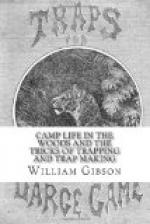[Illustration]
The use of the poison is very dangerous: a mere scratch through the skin is likely to prove fatal, and the trapper is thus likely to prove his own victim. Poisoned arrows are little used by trappers; and the bow trap, when properly constructed, is sufficiently effective without the venom.
THE DOWN-FALL.
This is the famous harpoon trap, so commonly used in Africa for the capture of the hippopotamus. There is no reason why [Page 27] it may not be successfully employed in our own country for taking large game, or modified on a reduced scale for smaller animals.
[Illustration]
The hippopotamus makes his daily rounds in regular beaten pathways; and the trapper, knowing this peculiarity, turns it to advantage. This is a common habit with many animals; and these “runways” are easily detected by the matted leaves and grass and the broken twigs. Over such a beaten track the harpoon-trap is suspended.
The harpoon used by the native African trappers somewhat resembles a double-barbed arrowhead, and has a reflexed prong on the shaft just behind the barbs,—a sort of combination between a spear and a fish-hook. It is a terrible weapon; and, when once launched into the flesh of its victim, its withdrawal is impossible, on account of the reflexed barb. Any sharp steel shaft will answer the purpose of the harpoon; it should be eight or ten inches in length, and filed to a keen point. We will now construct the trap. The first requisite is a straight section of the branch of some tree. This should be about four inches in diameter, and four feet in length. Into one end of this beam the harpoon should be firmly imbedded, allowing the point to project about six inches. This beam should [Page 28] then be weighted with two large stones, attached firmly by a rope, about eighteen inches above the harpoon. At about six inches from the other end of the log a notch should be cut, having its flat side uppermost, as shown plainly in our illustration. The implement is now ready.
Select some favorably situated tree, whose branches extend over the pathway chosen for the trap. By the aid of a rope secured to the log, and thrown over the limb, the weighted beam may be drawn up into the tree. While thus held by a person below, the trapper should climb the tree to complete operations. For this purpose, a smaller branch about three feet in length should be cut. One end should be flattened off on both sides, so as to fit in the notch in the beam; and the part which rests on the limb, as seen in the illustration, should also be flattened to prevent turning. A piece of stout Indian twine should next be fastened to the unwhittled end of the stick, which may then be adjusted in the notch of the harpoon beam, as seen in the engraving. The string may then be thrown down, and grasped by the companion below, who holds it firmly, after which the original




